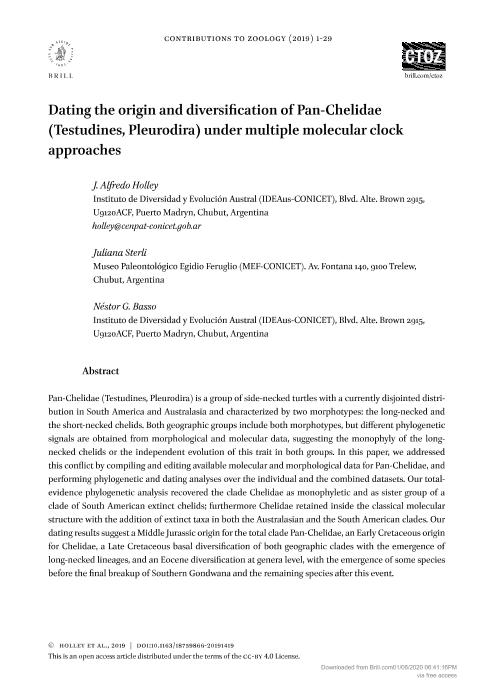Mostrar el registro sencillo del ítem
dc.contributor.author
Holley Reguiló, Juan Alfredo

dc.contributor.author
Sterli, Juliana

dc.contributor.author
Basso, Néstor G.
dc.date.available
2020-07-24T16:59:54Z
dc.date.issued
2019-12
dc.identifier.citation
Holley Reguiló, Juan Alfredo; Sterli, Juliana; Basso, Néstor G.; Dating the origin and diversification of Pan-Chelidae (Testudines, Pleurodira) under multiple molecular clock approaches; Brill Academic Publishers; Contributions To Zoology; 88; 2; 12-2019; 1-29
dc.identifier.issn
1383-4517
dc.identifier.uri
http://hdl.handle.net/11336/110198
dc.description.abstract
Pan-Chelidae (Testudines, Pleurodira) is a group of side-necked turtles with a currently disjointed distribution in South America and Australasia and characterized by two morphotypes: the long-necked and the short-necked chelids. Both geographic groups include both morphotypes, but different phylogenetic signals are obtained from morphological and molecular data, suggesting the monophyly of the long-necked chelids or the independent evolution of this trait in both groups. In this paper, we addressed this conflict by compiling and editing available molecular and morphological data for Pan-Chelidae, and performing phylogenetic and dating analyses over the individual and the combined datasets. Our total-evidence phylogenetic analysis recovered the clade Chelidae as monophyletic and as sister group of a clade of South American extinct chelids; furthermore Chelidae retained inside the classical molecular structure with the addition of extinct taxa in both the Australasian and the South American clades. Our dating results suggest a Middle Jurassic origin for the total clade Pan-Chelidae, an Early Cretaceous origin for Chelidae, a Late Cretaceous basal diversification of both geographic clades with the emergence of long-necked lineages, and an Eocene diversification at genera level, with the emergence of some species before the final breakup of Southern Gondwana and the remaining species after this event.
dc.format
application/pdf
dc.language.iso
eng
dc.publisher
Brill Academic Publishers

dc.rights
info:eu-repo/semantics/openAccess
dc.rights.uri
https://creativecommons.org/licenses/by/2.5/ar/
dc.subject
DIVERGENCE TIME
dc.subject
FBD MODEL
dc.subject
MOLECULAR CLOCK
dc.subject
PAN-CHELIDAE
dc.subject
TIP DATING
dc.subject.classification
Biología

dc.subject.classification
Ciencias Biológicas

dc.subject.classification
CIENCIAS NATURALES Y EXACTAS

dc.title
Dating the origin and diversification of Pan-Chelidae (Testudines, Pleurodira) under multiple molecular clock approaches
dc.type
info:eu-repo/semantics/article
dc.type
info:ar-repo/semantics/artículo
dc.type
info:eu-repo/semantics/publishedVersion
dc.date.updated
2020-06-19T18:22:08Z
dc.identifier.eissn
1875-9866
dc.journal.volume
88
dc.journal.number
2
dc.journal.pagination
1-29
dc.journal.pais
Países Bajos

dc.journal.ciudad
Amsterdam
dc.conicet.avisoEditorial
This is an open access article distributed under the terms of the CC-BY 4.0 License.
.
dc.description.fil
Fil: Holley Reguiló, Juan Alfredo. Consejo Nacional de Investigaciones Científicas y Técnicas. Centro Científico Tecnológico Conicet - Centro Nacional Patagónico. Instituto de Diversidad y Evolución Austral; Argentina
dc.description.fil
Fil: Sterli, Juliana. Museo Paleontológico Egidio Feruglio; Argentina. Consejo Nacional de Investigaciones Científicas y Técnicas; Argentina
dc.description.fil
Fil: Basso, Néstor G.. Consejo Nacional de Investigaciones Científicas y Técnicas. Centro Científico Tecnológico Conicet - Centro Nacional Patagónico. Instituto de Diversidad y Evolución Austral; Argentina
dc.journal.title
Contributions To Zoology

dc.relation.alternativeid
info:eu-repo/semantics/altIdentifier/url/https://brill.com/view/journals/ctoz/89/2/article-p146_146.xml
dc.relation.alternativeid
info:eu-repo/semantics/altIdentifier/doi/http://dx.doi.org/10.1163/18759866-20191419
Archivos asociados
